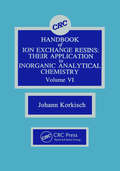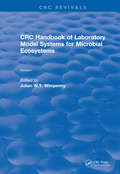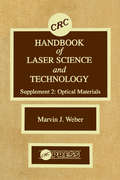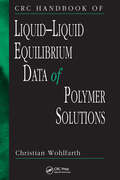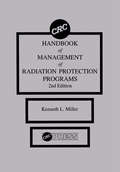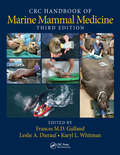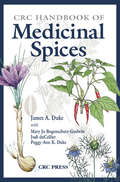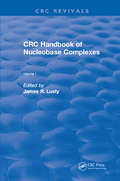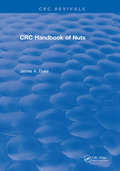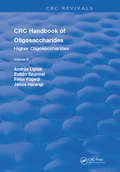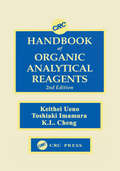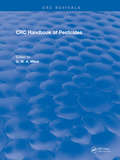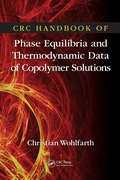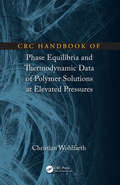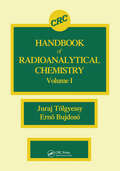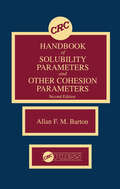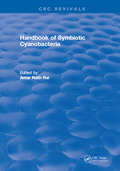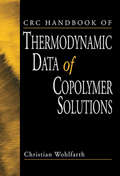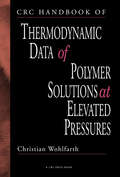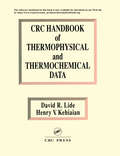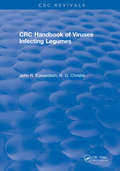- Table View
- List View
CRC Handbook of Ion Exchange Resins, Volume VI: Their Application To Inorganic Analytical Chemistry
by Johann KorkischThe six-volume CRC Handbook of Ion Exchange Resins reviews the application of ion exchange resins to inorganic analytical chemistry. Extracted from over 6,000 original publications, it presents the information in over 1,000 tables complemented by concise descriptions of analytical methods involving virtually all the elements of the periodic table. Also, the ion exchange characteristics of the elements, as well as other important information required by analysis using ion exchange resins, are presented in separate tables. The methods that allow the multi-element analysis of complex matrices are emphasized. This work includes a general discussion of the theoretical, instrumental, and other principles underlying the various applications of ion exchange resins in inorganic analytical chemistry with special attention focused on techniques based on ion chromatography.
CRC Handbook of Laboratory Model Systems for Microbial Ecosystems, Volume I (CRC Press Revivals)
by Julian W.T. WimpennyThese volumes present the main classes of useful laboratory model systems used to study microbial ecosystems, with emphasis on the practical details for the use of each model. The most commonly used model, the homogeneous fermenter, is featured along with linked homogeneous culture systems, film fermenters, and percolating columns. Additionally, gel-stabilized culture systems which incorporate molecular diffusion as their main solute transfer mechanism and the microbial colony are explained. Chapters comparing model systems with "microcosms" are included, along with discussions of the value of computer models in microbial ecosystem research. Highlighted is a global discussion of the value of laboratory models in microbial ecology.
CRC Handbook of Laser Science and Technology Supplement 2: Optical Materials (Laser And Optical Science And Technology Ser. #8)
by Marvin J. WeberIn the CRC Handbook of Laser Science and Technology: Supplement 2, experts summarize the discovery and properties of new optical materials that have appeared since the publication of Volumes III-V. Included are the latest advances in optical crystals, glasses and plastics, laser host materials, phase conjugation materials, linear electrooptic materials, nonlinear optical materials, magnetooptic materials, elastooptic materials, photorefractive materials, liquid crystals, and thin film coatings. The book also includes expanded coverage of optical waveguide materials and new sections on optical liquids, glass fiber lasers, diamond optics, and gradient index materials. Appendices include Designation of Russian Optical Glasses; Abbreviations, Acronyms, and Mineralogical or Common Names for Optical Materials; and Abbreviations for Methods of Preparing Optical Materials. Extensive tabulations of materials properties with references to the primary literature are provided throughout the supplement. The CRC Handbook of Laser Science and Technology: Supplement 2 represents the latest volume in the most comprehensive, up-to-date listing of the properties of optical materials for lasers and laser systems, making it an essential reference work for all scientists and engineers working in laser research and development.
CRC Handbook of Liquid-Liquid Equilibrium Data of Polymer Solutions
by Christian WohlfarthThermodynamic data form the basis for separation processes used in different fields of science and industry, from specialty chemicals to foods and pharmaceuticals. One obstacle to developing new production processes, products, or optimization is the lack, or inaccessibility, of experimental data related to phase equilibrium.Access More Than 1200 Data Sets, Including 810 Binary Systems, 325 Ternary Systems, and 25 Quaternary (or Higher) SystemsThe CRC Handbook of Liquid-Liquid Equilibrium Data of Polymer Solutions provides a thorough and up-to-date compilation of experimental liquid-liquid equilibrium (LLE) data and their original sources. Arranged in a consistent format, the handbook provides convenient access to cloud-point and coexistence data as well as upper and lower critical solution temperatures and important demixing data for each system.An Excellent Companion to the Author’s Previous Collections of Thermodynamic Data!While the author’s previous data compilations center around specific types of polymer systems, Wohlfharth’s latest work distinguishes itself by focusing instead on representing LLE data for all types of polymer systems in a single source.
CRC Handbook of Management of Radiation Protection Programs, Second Edition
by Kenneth L. MillerCRC Handbook of Management of Radiation Protection Programs, 2nd Edition, is unique in that it offers practical guidance for managing various aspects of radiation protection programs ranging from the daily operation of a health physics office to the preparation of radiation experts for court appearances as professional witnesses. The book also covers such topics as organization and management of nonionizing radiation safety programs (with special emphasis on laser safety programs) and management of radioactive waste, personnel monitoring programs, radiation accident victims, internal exposure, relative radiotoxicity and radiation therapy patients. Other chapters discuss handling radiation accidents and education and training requirements for radiation protection. Legal aspects covered in the book include the history of radiation court cases, legal implications of record keeping, and preparation for court appearances. CRC Handbook of Management of Radiation Protection Programs, 2nd Edition will be a valuable reference resource for medical and health physicists, industrial hygienists, physicians, nuclear engineers, radiation protection regulators, radiation emergency management agents, radiation safety committees, and managers of facilities using ionizing and nonionizing radiation sources.
CRC Handbook of Marine Mammal Medicine
by Frances M.D. Gulland Leslie A. Dierauf Karyl L. WhitmanAAP Prose Award Finalist 2018/19 Key features: Covers all aspects of marine mammal veterinary practice Written by internationally acknowledged experts Adds new chapters on Ophthalmology, Dentistry, Ethics, Oil Spill Response, Health Assessments, Whale Entanglement Response, Dive Response, and Biotoxins Richly illustrated in color throughout the new edition including updated anatomical drawings and extensive photographs of ocular lesions Provides guidance to websites that regularly present updated information and images pertinent to current marine mammal medicine such as imaging and stranding network contacts Discusses ethics and animal welfare For three decades, this book has been acknowledged as the most respected scientific reference specifically devoted to marine mammal medicine and health. Written by approximately 100 contributors who are recognized globally as leaders in their respective fields, the CRC Handbook of Marine Mammal Medicine, Third Edition continues to serve as the essential guide for all practitioners involved with marine mammals including veterinarians, technicians, biological researchers, students, managers, keepers, curators, and trainers. The 45 chapters provide essential information for the practitioner on pathology, infectious diseases, medical treatment, anesthesia, surgery, husbandry, health assessment, species-specific medicine, medically pertinent anatomy and physiology, and global health concerns such as strandings, oil spills, and entanglements of marine mammals. The book guides the reader through the veterinary care of cetaceans, pinnipeds, manatees, sea otters, and polar bears. In addition to summaries of current knowledge, chapters provide information on those digital resources and websites which present the latest information as it emerges in the field. The CRC Handbook of Marine Mammal Medicine, Third Edition gives a call to action for scientists to experiment with new endeavors to engage and inspire current and future generations to care for marine mammals and the marine environment, and work together to find solutions. As the most trusted reference for marine mammal conservation medicine and for marine mammal medical facilities around the world, this book needs to be in your library.
CRC Handbook of Medicinal Spices
by James A. Duke Mary Jo Bogenschutz-Godwin Judi DuCellier Peggy-Ann K. Duke"Let food be your medicine, medicine your food."-Hippocrates, 2400 B.C.When the "Father of Medicine" uttered those famous words, spices were as important for medicine, embalming, preserving food, and masking bad odors as they were for more mundane culinary matters. Author James A. Duke predicts that spices such as capsicum, cinnamon, garlic, ginger
CRC Handbook of Nucleobase Complexes: Transition Metal Complexes Of Naturally Occurring Nucleobases And Their Derivatives (CRC Press Revivals)
by James R. LustyThe purpose of this easy-to-use handbook is to provide a quick, accessible reference to nucleobase complexes. It describes these complexes with reference to methods of preparation, their characterization, and their toxicity and therapeutic indices. It lists the modes of coordination together with the relevant spectral data and major methods of investigation. This concise resource guide also includes data on the uncomplexed bases, such as solubility, pk, accepted structures in the solid state and solutions, and the natural occurrence of the base. Investigators in the fields of transition metal chemistry, biological inorganic chemistry and those working in medical laboratories will find this handbook indispensable.
CRC Handbook of Nuts
by James A. DukeOver one hundred of the world's most important species of nuts are systematically accounted in this informative handbook. The text defines nuts and discusses their economic and nutritional value. For easy reference; there is an illustrated account of each nut by species, arranged alphabetically by scientific name. Each account includes the family name, several colloquial names, and paragraphs on uses, folk medicine, chemistry, germplasm, distribution, ecol-ogy, cultivation, harvesting, yields, energy, and biotic factors.Chapters Describe:UsesFolk medicineChemistryGermplasmDistributionEcologyCultivationHarvestingYields and economicsEnergyBiotic factors
CRC Handbook of Oligosaccharides: Volume 3
by Andras LiptakChemical synthesis of oligosaccharides is important to organic chemistry because of the critical biological functions of carbohydrates. Unfortunately, no handbook has been published on the subject...until now. CRC Handbook of Oligosaccharides is a series of three volumes that includes all oligosaccharides synthesized between 1960 and 1986. This allows oligosaccharides prepared in their free form to be presented, as well as those produced in protected form. The series contains data regarding glycosylation reaction, namely reaction conditions (solvent, promoter, temperature), the aglycon and the glycosyl donor used, and the structure and physical data of the isolated product. For disaccharides, the names of the reactants and the products are revealed, while with trisaccharides and higher oligomers, schematic figures provide a quick and easy way to access information concerning the entire process. These volumes will provide an important reference source for biochemists, biologists, and organic chemists.
CRC Handbook of Optical Resolutions via Diastereomeric Salt Formation
by David KozmaOptically active compounds are gaining ever-increasing importance in organic chemistry, both in the academic and the industrial arenas. The rational synthesis of the growing number of chiral chemicals, drugs, and natural products demands efficient methods for producing these compounds in an enantiomerically, highly pure form. Despite the available
CRC Handbook of Organic Analytical Reagents
by Kuang Lu Cheng Keihei Ueno Toshiaki ImamuraThe Handbook of Organic Analytical Reagents, 2nd Edition, is an indispensable source book of physico-chemical properties, preparation, and analytical applications of the most commonly used organic reagents. Updated from the 1st Edition, this volume includes data on 40 new reagents (such as ultra-high sensitive azo dyes, fluorescent calcium indicators, and chromogenic crown ethers and porphyrin reagents), a new Reagent Index listing reagents according to the elements to be assayed, and completely updated references. Each entry contains information on synonyms, sources and methods of synthesis, analytical applications, complexation reactions and the properties of complexes, purification and purity of the reagent, and other regeants with a related structure. The Handbook of Organic Analytical Reagents, 2nd Edition, is an invaluable bench-side reference for professional analytical chemists and graduate students.
CRC Handbook of Pesticides
by G.W.A. MilneThis new compilation focuses on 386 of the most commonly used pesticides recently registered by the EPA. The structural and molecular formulas are listed for each chemical along with its Chemical Abstracts Registry Number (CAS RN) and, when available, its number in the Merck Index (Eleventh Edition). This invaluable reference provides the various English and foreign chemical names, trivial names, synonyms, and trade names for each pesticide. A handy chemical name index also presents this information in a readily accessible format. The pesticide's physical properties are summarized and data pertaining to the compound's acute toxicity in various species are given. This data has been drawn from the Registry of Toxic Effects of Chemical Substances. Finally, for each of the pesticide chemicals there is a reference to the appropriate Section of the Code of Federal Regulations, 40 CFR 180, where the various crop tolerances may be located.
CRC Handbook of Phase Equilibria and Thermodynamic Data of Aqueous Polymer Solutions
by Christian WohlfarthA large amount of experimental data has been published since the debut of the original CRC Handbook of Thermodynamic Data of Aqueous Polymer Solutions. Incorporating new and updated material, the CRC Handbook of Phase Equilibria and Thermodynamic Data of Aqueous Polymer Solutions provides a comprehensive collection of thermodynamic data of polymer
CRC Handbook of Phase Equilibria and Thermodynamic Data of Copolymer Solutions
by Christian WohlfarthTen years after the debut of the expansive CRC Handbook of Thermodynamic Data of Copolymer Solutions, The CRC Handbook of Phase Equilibria and Thermodynamic Data of Copolymer Solutions updates and expands the world's first comprehensive source of this vital data. Author Christian Wohlfarth, a chemical thermodynamicist specializing in phase equilibr
CRC Handbook of Phase Equilibria and Thermodynamic Data of Polymer Solutions at Elevated Pressures
by Christian WohlfarthThere is a continuing interest in thermodynamic properties of polymer solutions at elevated pressures. This updated book provides newly published experimental data from the last decade. It includes nearly 500 newly published references containing approximately 175 new vapor-liquid equilibrium data sets, 25 new liquid-liquid equilibrium data sets, 540 new high-pressure fluid phase equilibrium data sets, 60 new data sets describing PVT properties of polymers, and 20 new data sets with densities or excess volumes.
CRC Handbook of Radioanalytical ChemistryVolume 1
by Juraj Tolgyessy Erno BujdosoRadioanalytical methods have become among the most important means for elemental analysis and the determination of chemical species Their extreme sensitivity has made them indispensable in a wide range of applications, including mineral analysis, medical and biophysical work, criminology, history, archaeology, and space research. This handbook combines theoretical and practical radioanalytical work covering the entire field of radioanalytical chemistry. Topics discussed include analysis by activation and nuclearreactions, isotope dilution analysis, radioreagent methods, analysis by absorption and the scattering of radiation. The handbook is extremely useful to scientists conducting applied and basic research in subjects related to analytical measurements, engineers designing control facilities and equipment, and professors and students working with analyticalchemistry, radiochemistry, radioanalytical chemistry, enviromental chemistry, biology, and physics.
CRC Handbook of Solubility Parameters and Other Cohesion Parameters: Second Edition
by Allan F.M. BartonThe CRC Handbook of Solubility Parameters and Other Cohesion Parameters, Second Edition, which includes 17 new sections and 40 new data tables, incorporates information from a vast amount of material published over the last ten years. The volume is based on a bibliography of 2,900 reports, including 1,200 new citations. The detailed, careful construction of the handbook develops the concept of solubility parameters from empirical, thermodynamic, and molecular points of view and demonstrates their application to liquid, gas, solid, and polymer systems.
CRC Handbook of Symbiotic Cyanobacteria
by Amar Nath RaiIn one convenient source, this ready reference brings together for the first time, all the information available on various cyanobacterial symbioses/symbiotic cyanobacteria. Comprehensive data on structure, physiology, biochemistry and molecular biology of the cyanobiont in various cyanobacterial symbioses is included. Aplied aspects such as use of Azolla in rice cultivation and artificial symbioses are addressed, along with a chapter dedicated to methodology. This informative new text is useful to researchers, teachers, and students.
CRC Handbook of Thermal Engineering (Mechanical and Aerospace Engineering Series)
by Raj P. ChhabraThe CRC Handbook of Thermal Engineering, Second Edition, is a fully updated version of this respected reference work, with chapters written by leading experts. Its first part covers basic concepts, equations and principles of thermodynamics, heat transfer, and fluid dynamics. Following that is detailed coverage of major application areas, such as bioengineering, energy-efficient building systems, traditional and renewable energy sources, food processing, and aerospace heat transfer topics. The latest numerical and computational tools, microscale and nanoscale engineering, and new complex-structured materials are also presented. Designed for easy reference, this new edition is a must-have volume for engineers and researchers around the globe.
CRC Handbook of Thermodynamic Data of Aqueous Polymer Solutions
by Christian WohlfarthProviding the necessary basis for any developments of theoretical thermodynamic models, this book provides a complete collection of practical thermodynamic data for a variety of applications, including: basic and applied chemistry, chemical engineering, thermodynamic research, computational modeling, membrane science and technology, and environmental and green chemistry. The data -- which includes such developments as vapor-liquid and liquid-liquid equilibria, low-and high-pressure equilibrium data, enthalpic and volumetric data, and second virial coefficients -- is necessary when studying intermolecular interactions and gaining insights into the molecular nature of mixtures.
CRC Handbook of Thermodynamic Data of Copolymer Solutions
by Christian WohlfarthThermodynamic data of copolymer solutions are a necessity for industrial and laboratory processes and serve as essential tools for understanding the physical behavior of copolymer solutions, intermolecular interactions, and the molecular nature of mixtures. Scientists and engineers in both academic and industrial research need this data. This handbook compiles original data gathered from approximately 300 literature source and provides 250 vapor-pressure isotherms, 75 tables of Henry's constants, 225 data sets, and 70 PVT tables for more than 100 copolymers and 165 solvents. It is the first complete overview of this complex subject.
CRC Handbook of Thermodynamic Data of Polymer Solutions at Elevated Pressures
by Christian WohlfarthThis handbook provides the only complete collection of high-pressure thermodynamic data that is essential for understanding polymer solutions. It contains data on vapor-liquid equilibria and gas solubilities, liquid-liquid equilibria, high-pressure fluid phase equilibria for polymer systems in supercritical fluids, enthalpic and volumetric data, as well as second virial coefficients all at elevated pressures. It covers all areas needed by researchers and engineers who handle polymer systems in supercritical fluids; materials science and technological applications such as computerized predictive packages; and chemical and biochemical processes, such as synthesis and characterization, fractionation, separation, purification, and finishing of polymers and related materials.
CRC Handbook of Thermophysical and Thermochemical Data
by David R. Lide Henry V. KehiaianThe CRC Handbook of Thermophysical and Thermochemical Data is an interactive software and handbook package that provides an invaluable source of reliable data embracing a wide range of properties of chemical substances, mixtures, and reacting systems. Use the handbook and software together to quickly, and easily generate property values at any desired temperature, pressure, or mixture composition.
CRC Handbook of Viruses Infecting Legumes
by John R. EdwardsonThis interesting handbook discusses 145 plant viruses in 27 groups and 31 unclassified viruses in naturally infected legumes. The viruses were observed in field infections of 281 species in 64 genera of the Leguminosae. The book presents information regarding resistance sources and resistance-breeding, vectors, seed transmission, and host ranges. Measurements of virus properties are organized in tabular form for particle dimensions, serological relationships, nucleic acid percentages, sedimentation coefficients of particles and nucleic acids, molecular weights of nucleic acids and coat proteins, optical density, and buoyant density. Handbook of Viruses Infecting Legumes is unique in that it relates inclusion cytology to plant virus detection, identification, and classification. Light and electron micrographs illustrate morphology, location, and staining reactions of inclusions. Of the 27 groups that contain viruses infecting legumes in nature, inclusions are diagnostic at the group level in 15 of these groups. Plant breeders, diagnosticians, plant virologists, and students of plant virology will find this an indispensable guide to legume viruses.
